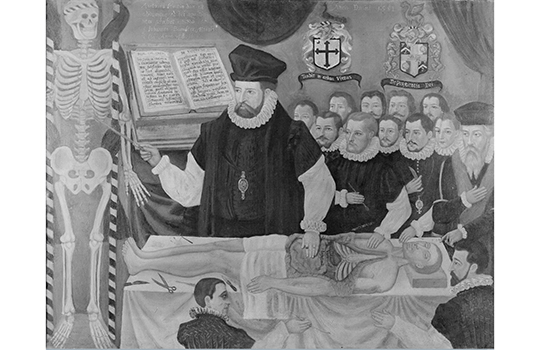John Banester (1533 -1610) was an English surgeon and educator. He learned his surgery by going to war—he went on a military expedition to the continent. On his return to England he was keen to pass on what he had learned—and here he is teaching at the Barber-Surgeons’ Hall.

Credit: MPL, Wellcome Images [1]
The picture is worth a closer look. I think that Banester is “adopting a multimedia approach to his presentation.” [2] He is speaking, palpating, and pointing things out. He is surrounded by a cadaver, a skeleton, and a textbook. His learners are looking, listening, reading, and discussing among themselves. We might think that we invented multimedia—but it has clearly been around a long time.
The most recent addition to multimedia is video. There are many advantages to using video in medical education and clinical decision support. Video can be published online and so made available to unlimited numbers of learners. Interactive video can enable learners to test and train their skills online. Video can help medical students and doctors to learn communication skills and team working skills. The best videos can help learners to integrate these skills and put them into practice for the benefit of patients.
Dong et al have published an interesting paper on the uses of video in medicine. [3] Their paper offers a range of tips—one of which is that videos should be aligned and integrated with the rest of the content in the curriculum. They also advise that videos be kept short—to keep with short attention spans. Short content also helps to avoid cognitive overload—which can interfere with the learning process.
We have tried to put these tips into practice when creating videos for our users. Many of our videos cover clinical procedures—such as how to do a lumbar puncture. The videos are short and are aligned with simple guidelines on when you should or shouldn’t do a lumbar puncture. Most importantly they are now integrated in our clinical decision support resource—BMJ Best Practice. The idea is that you might see a patient who needs a lumbar puncture. You could read about the procedure and then watch a video of the procedure being completed—all on your phone—online or offline. The whole process takes a few minutes and offers integration at a granular level—integration at the point of care.
What would John Banester have made of it? The picture suggests that he was ahead of his contemporaries and understood the power of multimedia. In the sixteenth century, lectures meant the educator reading texts to his learners. Text will always have a primary role in medical education but, when learning how to do a procedure, multimedia is simply better. In the twenty-first century, our opportunity is to take multimedia out of the lecture hall and onto the ward. There we can use it to support clinical decisions at the point of care.
Kieran Walsh is clinical director of BMJ Learning and BMJ Best Practice. He is responsible for the editorial quality of both products. He has worked in the past as a hospital doctor—specialising in care of the elderly medicine and neurology.
Competing interests: Kieran Walsh works for BMJ, which produces the online clinical decision support tool BMJ Best Practice.
References:
- John Banester giving the visceral lecture at Barber-Surgeons’ Hall, London, in 1581. Oil By: Anonymous after: Orr, Jack.
Copyrighted work available under Creative Commons Attribution only licence CC BY 4.0 http://creativecommons.org/licenses/by/4.0/ - Walsh K. Medical education: a history in 100 images. CRC Press. London 2016.
- Dong C, Goh PS. Twelve tips for the effective use of videos in medical education. Med Teach.2015 Feb;37(2):140-5.
